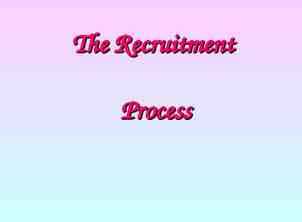Recruiting the liberal arts
19 Slides1.59 MB
Recruiting the liberal arts
The agenda The broader enrollment landscape What do students and parents want? How do we present ourselves? Additional insight into the freshman mindset Discussion
Sources used Ruffalo Noel Levitz, 2014 E-Expectations Report: The Impact of Mobile Browsing on the College Search Process. Cedar Rapids, IA: Noel-Levitz, 2014) Ruffalo Noel Levitz (2016). 2016 national freshman motivation to complete college report. Cedar Rapids, IA: Ruffalo Noel Levitz. Retrieve from www.RuffaloNL.com/Motivation. Ruffalo Noel Levitz (2006). 2006 national freshman motivation to complete college report. Cedar Rapids, IA: Ruffalo Noel Levitz. Retrieve from www.RuffaloNL.com/Motivation.
The broader enrollment landscape
Higher education’s compounded annual growth rates are slowing 1963-1980 2000-2010 2013-2024 5.6% 3.2% 1.2% Note: Between 1981 and 1999 the compounded growth rate w Source: U.S. Department of Education. Institute of Education Sciences, National Center for Education Statistics. 2014 Digest Ed Statistics: Table 310.10
Texas The competition factor 307,504 high school seniors / 2015-16* 281 institutions of higher education** 56.2% college continuation rate (172,817)*** (ranks 42nd among states) 11.7% leave the state to go to college (20,294)**** (ranks 38th among states) In-state institutions receiving the largest number of in-state freshmen. †† Competition factor equals college continuation rate less number of students migrating and the three instate institutions receiving the largest number of in-state freshmen. † Three Largest Institutions †***** Number of In-state Freshmen***** Texas A & M University – College Station 10,234 The University of Texas at Austin 6,420 College 278 institutionsBlinn competing for 130,1435,726 students annually Sources: *Western Interstate Commission for Higher Education, Knocking at the College Door, 2012 **The Chronicle of Higher Education, 2015 ***Postsecondary Education Opportunity, Chance for College by Age 19 by State 1986-2010, 2013 ****Postsecondary Education Opportunity, Interstate Migration of College Freshmen 1986-2012, 2014 *****National Center for Education Statistics, IPEDS Fall Enrollment Survey (2014)
Projected number of high school graduates by ethnicity: Texas 201220 White 200,000 180,000 160,000 140,000 120,000 100,000 80,000 60,000 40,000 20,000 0 Black Hispanic 13 14 15 16 17 18 19 20 21 2 3 4 5 6 7 8 9 0 1 1 1 1 1 1 1 1 2 20 20 20 20 20 20 20 20 20 December 2012. Knocking at the College Door. Western Interstate Commission for Higher Education
Future entering classes will potentially be: More ethnically diverse Financially needier Heavier in first or second generation college students In addition, the cohort entering in 2017 will experience major changes in the SAT, the FAFSA, and major changes in state curriculum and testing standards.
What do students and parents want?
The career factor Reported major choices by SAT takers indicate that students (and parents) view higher education through the eyes of potential careers. Five areas (biology, business, engineering, health professions, and psychology) account for the reported majors of 61% of test submitters to Austin College. Those same five areas comprise 54% of all SAT test takers in our region. Please refer to your handout. How in the heck are we supposed to turn out good citizens if all these kids want to be doctors, investment bankers, or engineers?
How do we reach more students effectively?
Where does this fit? How do we reach these kids?
How do we represent ourselves?
Examples of recruitment strategies Austin College Music Department – targeted approach to generate applications. Dr. Mark Hebert – one man on a mission to convert applicants and admits. Foreign Language – experiential learning and a unique opportunity at AC. What part of the funnel are we recruiting in these examples?
How do we talk about careers in a liberal arts context? Gallup Purdue Index
We aren’t a career factory. We are a success factory.
In comparison to 2006 freshmen, 2016 freshmen are more likely to Question the point of college Feel more pressure Not read for pleasure Believe they have good study habits Feel as though they have strong family support Have identified a potential career path that affects their education plans Expect more academic services like tutoring Be more willing to work and less willing to pursue loans Not get along well with others expressing different options Sources: 2016 National Freshman Motivation to Complete College Report (RuffaloNoel Levitz) and 2006 National Freshman Motivation to Complete College Report (RuffaloNoel Levitz)
























